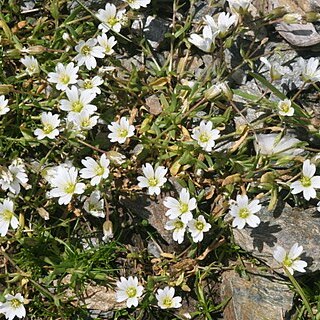Plants perennial, mat-forming, rhizomatous. Stems creeping, much-branched, rooting, glabrous except for line of small hairs down each internode; flowering shoots decumbent or ascending, 5-10 cm; nonflowering shoots prostrate, 5-15 cm; small axillary tufts of leaves usually absent. Leaves sessile, tending to be marcescent, somewhat succulent; blade elliptic-oblong or linear-lanceolate, 2-12 × 1-3 mm, apex obtuse, rarely acute, glabrous, sometimes ciliate at base. Inflorescences lax, 1-3-flowered terminal cymes; bracts lanceolate, 2-5 mm, glabrous or ciliate. Pedicels becoming curved, slender, 5-35 mm, equaling or exceeding sepals, glandular-puberulent. Flowers: sepals narrowly lanceolate, 4-5 mm, margins narrow, midrib present, apex obtuse, glandular-pubescent towards base; petals 5-8 mm, 1-1.5 times as long as sepals, apex deeply 2-fid; stamens 10; styles 3(-6). Capsules ovoid-conic, oblong after dehiscence, straight, 7-10 mm, 1.5-2 times as long as sepals; teeth 6(-12), erect to spreading, margins convolute. Seeds brown, 0.5 mm diam., shallowly rugose; testa not inflated. 2n = 38.
More
Herbs perennial, 10--20 cm tall. Stems caespitose, creeping basally, decumbent or ascending, branched distally, pubescent. Leaves linear-lanceolate, 8--20 × 1.5--2(--3) mm, apex acuminate. Cyme 3--7-flowered, rarely solitary; bracts leaflike, lanceolate. Pedicel 1.5--2 cm, glandular pubescent, recurved in fruit. Sepals broadly lanceolate, 4--6(--7) mm, 1-veined, margin membranous. Petals obovate, 8--12 mm, 2-lobed for ca. 1/4 their length. Stamens 10. Styles 3. Capsule cylindric, 10--12 mm, 6-toothed. Seeds reniform-globose, tuberculate. Fl. May--Aug, fr. Aug--Sep.

